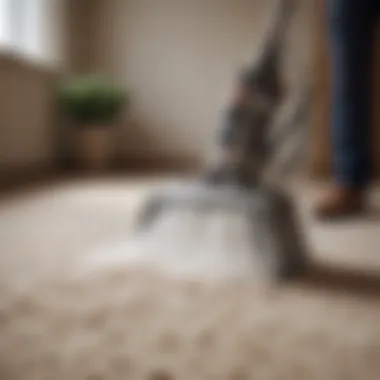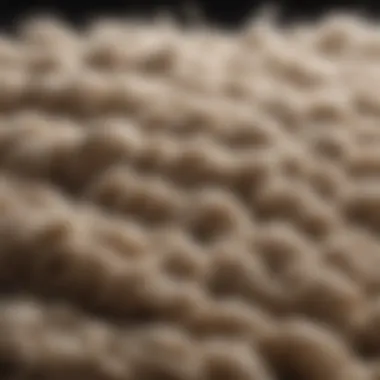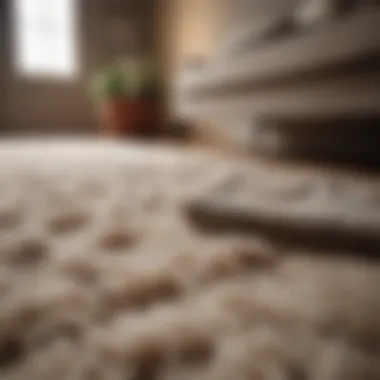The Feasibility of Steam Cleaning Wool Rugs


Intro
Wool rugs are a beautiful addition to any home. Their natural fibers offer warmth, comfort, and aesthetic appeal. However, maintaining these rugs requires special care, particularly when it comes to cleaning methods. One common option among homeowners is steam cleaning. This article examines the feasibility of using steam cleaning on wool rugs.
Steam cleaning seems like an efficient way to eliminate dirt and stains, but wool, being a delicate fiber, poses potential challenges when exposed to moisture and heat. The intricacies of wool’s structure mean that improper cleaning can cause shrinkage, discoloration, and even damage.
Understanding the effectiveness of steam cleaning entails evaluating multiple facets: the inherent properties of wool, the risks involved, and best practices for safe maintenance. This analysis aims to guide homeowners and cleaning professionals, presenting practical advice alongside alternative methods for wool rug care. By the end, readers can make informed decisions, ensuring their cherished rugs retain their integrity and beauty for years to come.
Prelims to Wool Rugs
Wool rugs are more than just decorative floor coverings; they are functional pieces that bring warmth and character to any space. Understanding their construction and maintenance is vital for homeowners, interior design enthusiasts, and anyone aiming to preserve the beauty and longevity of these items. In this section, we will explore wool as a material, along with the properties that make wool rugs popular choices in homes.
Understanding Wool as a Material
Wool is a natural fiber derived from the fleece of sheep and other animals. Its unique structure contributes to its quality, making it resilient and versatile. One significant advantage of wool is its ability to absorb moisture, with it capable of holding up to 30% of its weight without feeling wet. This property also aids in regulating humidity levels in a room, benefiting both the rug and the indoor environment. Additionally, wool has natural elasticity, which allows it to bounce back after being compressed.
Moreover, the lanolin present in wool serves as a natural stain resistance, making wool rugs less prone to spills and stains compared to synthetic fibers. This trait enhances their practicality for households with children or pets. It's important to note that, while wool is luxurious, it can also be sensitive to excessive heat and moisture, warranting careful handling when cleaning.
Properties of Wool Rugs
Wool rugs have several properties that set them apart from other types of rugs. Among their most notable characteristics are:
- Durability: Wool is a durable material that can withstand heavy foot traffic, making it suitable for various areas in the home.
- Insulation: The natural fiber provides insulation, helping keep spaces warm in winter and cool in summer.
- Sound Absorption: Wool rugs also contribute to sound dampening, reducing noise levels in a room.
- Aesthetic Appeal: Available in a range of designs, colors, and patterns, wool rugs can complement any decor style.
However, wool rugs can have certain drawbacks. Their initial cost can be higher compared to synthetic options, reflecting the quality and craftsmanship involved. Maintenance is also an ongoing consideration, as they may require specific cleaning techniques to maintain their integrity and appearance.
The Process of Steam Cleaning
Steam cleaning is a process that employs heat and moisture to clean surfaces and materials. Understanding this process is crucial, especially when considering wool rugs, which require careful treatment. The importance lies not only in the effectiveness of cleaning but also in how the methods interact with the delicate fibers of wool. By exploring this topic, one can appreciate both the benefits and potential pitfalls that come with steam cleaning wool rugs.
What is Steam Cleaning?


Steam cleaning involves using a machine that heats water to create steam. The steam is then applied to surfaces, helping to lift dirt, stains, and allergens. In the context of wool rugs, steam cleaning can effectively sanitize and refresh the fibers. The high temperature of the steam eliminates bacteria and dust mites, providing a cleaner environment.
It's essential to note that this method uses less water in comparison to traditional cleaning. Reduced water usage is particularly beneficial for wool rugs, as excessive moisture can lead to mold or mildew. That said, steam cleaning needs to be done correctly to avoid damaging the natural fibers.
Equipment Used for Steam Cleaning
The equipment includes several key components that aid in the steam cleaning process.
- Steam Cleaner: A specialized machine that heats water and produces steam. It's available in various models, ranging from handheld devices to larger upright units.
- Nozzle Attachments: Different types of nozzles allow for versatility in cleaning various surfaces. For wool rugs, a gentle nozzle can prevent damage to the fibers.
- Water Tank: This holds the water used for steam generation. Some machines come with a larger capacity, allowing for more extended periods of cleaning without needing a refill.
- Safety Features: Given the high temperatures involved, good steam cleaning machines have safety mechanisms to prevent burns or malfunctions.
Prior to using any device, it is crucial to read the manufacturer’s guidelines fully. This assures that the steam cleaner is compatible with wool rugs and helps mitigate risks associated with improper use.
In summary, the process of steam cleaning involves both understanding how steam cleaning works and ensuring you have the right equipment for the task. This knowledge is essential for anyone considering this method for wool rug maintenance.
Can Wool Rugs Be Steam Cleaned?
Steam cleaning wool rugs raises significant questions around the practicality and safety of the process. Understanding whether these delicate fibers can withstand the intense heat and moisture is crucial for both homeowners and professional cleaners alike. Wool rugs, known for their natural beauty and durability, also require careful maintenance to keep them in optimal condition. This section examines the nuances of steam cleaning wool rugs, considering both the advantages and potential issues.
Advantages of Steam Cleaning Wool Rugs
Steam cleaning presents several benefits that make it an attractive cleaning option for wool rugs. Firstly, the high temperature of the steam effectively loosens dirt and debris that may have settled deep within the rug fibers. This level of cleaning can refresh the rug, improving its appearance significantly.
Additionally, steam cleaning is a chemical-free method. This is especially important for households with children or pets, as harsh chemicals in traditional cleaners may pose health risks. The use of steam not only cleans but also sanitizes the surface, as the heat eliminates bacteria and allergens.
Moreover, steam cleaning can increase the longevity of wool rugs. Regular maintenance using the right approach can prolong the life of precious rugs, keeping them looking vibrant for many years.
Potential Risks and Drawbacks
While steam cleaning offers distinct benefits, it also entails certain risks that warrant consideration. One significant concern is the moisture content introduced during the process. Wool naturally absorbs moisture, and excessive wetness can result in mildew or mold growth if not dried properly. This can lead to irreversible damage to the rug, affecting its integrity and value.
Furthermore, the heat that accompanies steam cleaning can be problematic for some wool rugs. Certain wool types may shrink or become misshapen if exposed to intense heat for prolonged periods. Additionally, dyes used in wool rugs can bleed when subjected to heat and moisture, resulting in discoloration and uneven coloring.


In summary, while steam cleaning can provide a deep clean, it is essential to weigh its advantages against the possible risks. Homeowners should assess the specific conditions and requirements of their wool rugs to make informed decisions about the cleaning methods they choose.
Moisture and Wool Rugs
Understanding the interaction between moisture and wool rugs is essential for their maintenance and longevity. Wool, being a natural fiber, has unique properties that make it sensitive to moisture. Recognizing these properties helps homeowners and cleaning professionals make informed choices regarding cleaning methods, especially concerning steam cleaning. Analyzing moisture’s role in wool rugs will provide clarity on how to preserve their beauty and functionality.
The Nature of Wool's Moisture Absorption
Wool has hygroscopic characteristics, meaning it can absorb moisture from the environment. This property allows wool rugs to regulate humidity levels in a room, enhancing indoor climate. On average, wool can absorb up to 30% of its weight in moisture without feeling wet, which is significant.
However, it is important to note that this ability can vary based on environmental conditions, such as temperature and humidity. Wool fibers will expand when absorbing moisture and contract as they dry. This dynamic is essential for maintaining the material’s structure and appearance.
The moisture absorption also influences dye retention. Wool can hold dyes effectively, leading to rich, vibrant colors in rugs. Nonetheless, excessive moisture can alter these dye properties, leading to bleeding or fading. Thus, managing moisture is crucial for both maintaining the quality and aesthetic of wool rugs.
Impacts of Excess Moisture
Excess moisture can be detrimental to wool rugs. Prolonged exposure to high humidity can result in various issues:
- Mold and Mildew Development: Wool's moisture retention can encourage mold growth, particularly in damp environments. This not only damages the rug but also poses health risks.
- Structural Degradation: When wool remains wet for extended periods, it can weaken the fibers. This compromises the integrity of the rug, making it prone to tearing or fraying.
- Unpleasant Odors: Moisture can create musty smells, which can be difficult to remove once they penetrate the fibers.
- Attracting Pests: Excess moisture can attract insects such as moths, which may damage the rug further by feeding on the fibers.
Best Practices for Cleaning Wool Rugs
Effective cleaning of wool rugs is crucial for maintaining their appearance and longevity. This section discusses best practices related to cleaning these delicate textiles, highlighting key elements such as methods, frequency, and considerations unique to wool.
Recommended Cleaning Methods
When it comes to cleaning wool rugs, the approach you choose can significantly impact their aesthetics and durability. Here are some of the recommended methods:
- Vacuuming: Regular vacuuming is essential. Use a vacuum cleaner with a suction setting suitable for wool to avoid damaging the fibers. Aim to vacuum at least once a week.
- Spot Cleaning: For immediate attention to spills, use a blotting technique. Uptake any liquid immediately using paper towels or a soft cloth. Avoid rubbing, as this can cause more damage.
- Shampooing: Utilize a wool-safe shampoo when deeper cleaning is necessary. Dilute the shampoo with water according to package instructions and apply it with a sponge. Rinse thoroughly to remove residue, ensuring the rug doesn’t stay too wet.
- Professional Cleaning Services: Depending on the rug's condition, professional cleaning might be beneficial. Look for specialists who understand wool. They have access to safer cleaning agents and equipment that can effectively clean without causing damage.
DIY Cleaning Techniques


For those who prefer a hands-on approach, several DIY methods can effectively clean wool rugs:
- Baking Soda: This natural deodorizer can help lift dirt and odors from your rug. Sprinkle baking soda on the rug, let it sit for a few hours, and then vacuum it up.
- Vinegar Solution: A mixture of equal parts water and white vinegar can be effective for certain stains. Test this solution on a small area first to ensure it doesn't discolor the fibers.
- Soap and Water: Create a gentle cleaning solution with mild soap and warm water. Use a clean cloth to blot the soiled areas, rinsing the cloth often.
- Air Drying: If your rug does get wet, ensure it dries completely. Lay it flat in a well-ventilated area, avoiding direct sunlight which can fade colors.
When to Seek Professional Help
Maintaining wool rugs requires a careful balance between proper cleaning techniques and understanding when to turn to experts. Homeowners often underestimate the nuances of cleaning wool rugs. If one uses the wrong method, it may cause irreversible damage. Therefore, recognizing the signs that a professional cleaning service is needed is crucial.
Signs Your Wool Rug Needs Professional Cleaning
Several indicators can suggest that a wool rug requires the attention of professionals. Here are some of the most common symptoms:
- Stains That Won't Come Out: If you have tried various home remedies and regular cleaning methods, yet the stains remain, it may be time for professional intervention.
- Foul Odors: Unpleasant odors can develop from dirt and moisture trapped in the fibers. If cleaning has not resolved this issue, a deeper clean might be necessary.
- Visible Dirt and Grime: Over time, dirt accumulates, and when it becomes apparent on the surface, it may be time for a professional clean.
- Damage from Pets: Pets can cause specific damage, whether from accidents or scratching. Professionals have techniques to address both issues properly.
- Allergies: If cleaning at home does not alleviate allergy symptoms, professional cleaning may help eliminate dust and allergens embedded in the rug.
Professional cleaners possess specialized equipment and trained expertise to tackle these problems, ensuring a thorough clean without harming the wool fibers.
Choosing the Right Cleaning Service
Once the need for professional cleaning is established, selecting the right service becomes a critical next step. There are specific elements to consider when making your choice:
- Experience with Wool: Ensure the cleaning service has experience specifically with wool rugs. Different materials require different care.
- Methodology: Investigate the cleaning methods used. The steam cleaning process may not be suitable for wool if not handled correctly. Inquire about their techniques and products.
- Reputation: Look for reviews or testimonials from previous clients. A trustworthy service should have positive feedback about their work.
- Certifications: Check if the company is certified by relevant organizations. This can indicate they meet industry standards for cleaning.
- Insurance and Warranty: A reputable cleaning service will have insurance and offer warranties for their work. This adds an extra layer of protection for your investment.
"Seeking professional help for wool rug cleaning is often the best decision to preserve the quality and longevity of the rug."
Ultimately, engaging with professionals can ensure that wool rugs are treated with the care they deserve, prolonging their life and maintaining their aesthetics.
The End
The conclusion serves as the pivotal component of this article, encapsulating the multifaceted discussion on steam cleaning wool rugs. Understanding the feasibility of this cleaning method is vital for homeowners and professionals alike. It informs decisions about maintenance practices that directly impact the longevity and appearance of wool rugs.
Summary of Key Findings
- Effectiveness of Steam Cleaning: The analysis reveals that steam cleaning can be an effective method for removing stains and dirt from wool rugs. Proper techniques yield positive results in most cases.
- Potential Risks: While benefits exist, concerns regarding the risk of damage to the fibers often come to the forefront. Overexposure to moisture may lead to shrinkage or distortion, thereby compromising the rug's integrity.
- Moisture Management: Wool's natural properties allow for moisture absorption. However, excessive moisture can foster mildew growth and promote deterioration. This article emphasizes the need for controlled moisture application during cleaning.
- Professional vs. DIY Cleaning: It is evident that some cleaning tasks should be left to professionals. They possess the expertise and equipment to mitigate risks, ensuring the best care for valuable rugs.
Final Recommendations
- Careful Application: If steam cleaning is chosen, ensure to use appropriate equipment and techniques. Focus on low moisture applications and brisk cleaning to avoid potential damage.
- Regular Maintenance: Instead of relying solely on steam cleaning, engage in regular vacuuming and spot clean as necessary. This proactive approach will maintain rug integrity over time.
- Professional Guidance: When in doubt, consult with professionals who specialize in wool rug care. They can offer tailored advice based on individual rug conditions and history.
In summary, the feasibility of steam cleaning wool rugs involves weighing its benefits against potential drawbacks. The recommendations put forward aim to empower homeowners and cleaning professionals to make informed choices that prioritize the health of wool rugs. By understanding these factors, one can enhance the cleanliness and durability of their investment.







